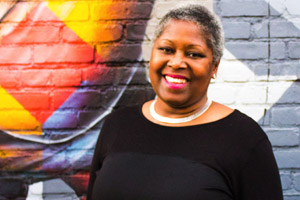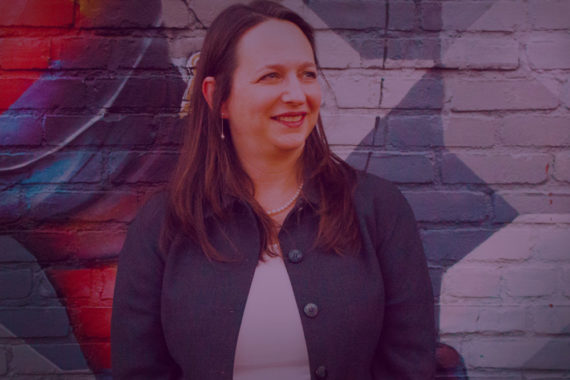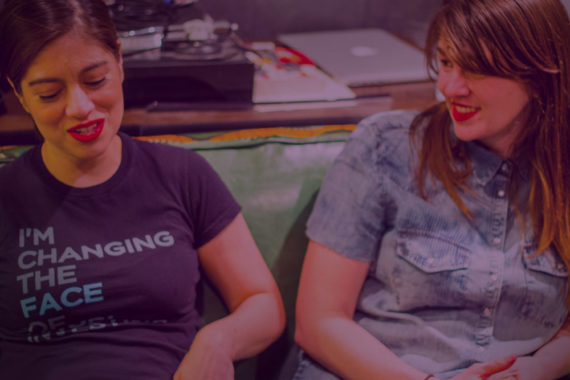
Kimberly Moore, Co-founder and CEO of Go Together
(photo credit: Kat Araujo)
Natalia gets the 60-second pitch from Kimberly Moore of Go Together, which helps schools coordinate parent carpools and walk pools. In the Legal Minute, Mitzi Chang of Goodwin answers common startup legal questions. Plus, this week’s Investor Take from Ruth Ann Harnisch of The Harnisch Foundation.
Music courtesy of Seven Seas Music (a Pipeline Angels portfolio company!)
EPISODE TRANSCRIPT
* indicates emphasis
Natalia: Hi everyone, my name is Natalia Oberti Noguera. I am the Host and Creator of Pitch Makeover and I’m also the founder and CEO of Pipeline Angels, where we are changing the face of angel investing and creating capital for women and non-binary femme social entrepreneurs.
Gina: And I’m Gina Delvac, the founding Executive Producer of Pitch Makeover. We’re taking the concept of a fashion makeover and applying it to startup pitches. Entrepreneurs pitch, we talk, and then we share some feedback on what they should keep, delete, and maybe even more important—add to their pitch. Our goal: help more voices—as Rihanna says—shine bright like the diamonds that they are.
And after the Pitch Makeover we have the Legal Minute with Mitzi Chang of Goodwin answering burning startup legal questions, followed by First Pitch, and stay to the end for this week’s Investor Take from Ruth Ann Harnisch of The Harnisch Foundation. [1:00]
Natalia: Hey everyone, welcome to Pitch Makeover. I am here with Kimberly Moore, co-founder and CEO of Go Together. Hi, Kimberly!
Kimberly: Hi, Natalia!
Natalia: Thanks for joining us here at Pitch Makeover.
Kimberly: Excited to be here.
Natalia: Are you ready to pitch?
Kimberly: I’m ready to pitch!
Natalia: Okay. Ready? Set? Go!
Kimberly: Transportation shouldn’t be the reason that a child doesn’t go to the school that they should go to, to be their best. But it happens every day. Parents do the hard work of finding the school or program that would help them be their best only to discover that the transportation options are limited or none at all. So, we at Carpool To School, our new product that’s out on the market, allows for parents through their school to create a trusted community to carpool, or even walk- and bike-pool. We’re in thirty-four schools in fifteen states and over sixteen thousand users. And we’re excited [2:00] because our annual subscription model really fits the school and it really helps the parents create that trusted community. Soon parents will be able to take the metro together as well.
So, we’re excited to be in this early phase of our business, scaling to a thousand schools by the end of 2017.
Gina: Fifty-eight seconds.
Natalia: Kimberly, that is fantastic and you’ve iterated a bit since, you know, our members heard you pitch in DC a while back.
Kimberly: Yeah.
Natalia: And guess what? These iterations seem to be getting you closer to business market fit. So, I’m so proud of you. I’m so excited for you!
Kimberly: Thank you! Thank you.
Natalia: It sounds like a key part of the business model now. It’s a B2B.
Kimberly: Yes.
Natalia: In a way. Which congrats! I think that’s really where the money is.
Kimberly: Yes.
Natalia: Oftentimes. It’s not where, like, oftentimes the headlines are. Right?
Kimberly: Yes, exactly.
Natalia: Because a lot of the—particularly the *tech* media—is so focused on consumer!
Kimberly: Consumers [3:00], yeah.
Natalia: Right? So hey, here’s to finding consumers who can pay, right?
Kimberly: Yes.
Natalia: Users who can pay! Although now I’ll be provocative, we’re talking about schools. So, would love to hear how was that been? Having schools as your potential users?
Kimberly: It’s actually been really great because in the U.S. alone, more than fifty percent of private schools and charters schools offer limited or no transportation. And so the paying point is really high. Especially since they’re delivering technology to the classroom, to the student and teacher, but to the parents they’re providing a spreadsheet and saying, “Figure it out.” Well, that’s no longer acceptable and they want technology to help them be more innovative in the way that they help solve that problem for parents.
There’s another thing that’s happening not only in the private school market but also in public schools, is the whole issue of traffic on campus. So we’re seeing longer traffic lines, pick-up [4:00] and drop-off lines, and it’s making them not be the best community citizen that they could be. And so for many communities across the country, particularly for California, we’re seeing the need for them to provide a transportation plan for how they’re going to reduce that traffic.
So, it’s actually been pretty interesting. We have more and more schools reaching out to us, both public schools and private schools, so we’re excited about it.
Natalia: And, you know what was interesting? I love that you focused on talking about an annual subscription model because oftentimes we hear about people who subscribe maybe a month or two, but then that’s it. So you’re already sharing that this is an annual relationship you’re establishing. And you mentioned, you know, over sixteen thousand users, etc. Like, how much is the annual subscription?
Kimberly: So it varies based on school enrollment; US$999 per school for [5:00] an enrollment up to five hundred students, and US$2999 annually for a school that has over two thousand students. And we also have a customization model that we can do. We also have additional revenue that we have at the first time of subscribing: the on boarding fee that varies from US$800 to US$1000 per school.
Natalia: So, tell me about—you mentioned how parents take the metro together. Tell me about that.
Kimberly: Yeah. We are so excited. So, without mentioning the client, we have this opportunity through a public school district. We were asked to look at our current Carpool To School platform and to bring in the metro because they’re in an urban context and they want their parents to have the options to have their kids take the metro bus or metro rail together. And they had no other solution for how that could happen and they thought to ask us if we would create that. So we’re going to do that.
Natalia: So is this—will you be piloting [6:00] this? It will be…
Kimberly: Yes.
Natalia: …like something new?
Kimberly: It’ll be something new.
Natalia: Okay. Kimberly, are you ready for my keep, delete, and add feedback.
Kimberly: I’m ready.
Natalia: Okay. So, I would say make sure to keep that awesome first sentence. That intro that you have about how transportation shouldn’t be the reason for children not to go to the school where they can be their best. It’s, like, that really caught my attention. It’s striking and resonated. Of course, keep your over sixteen thousand users, the fact that, like, you have an annual subscription business model. I’d say for my delete, I’d say especially now delete the metro option.
Kimberly: Okay.
Natalia: I feel like it’s distracting. I’m excited for you. You know, like, behind the scenes it’s so exciting, let’s talk about it. For someone who already knows what Go Together does and is: reducing the carbon footprint, all that stuff is awesome. For someone [7:00] who’s just getting to know Go Together for the first time, my sense is that it might be overwhelming.
Kimberly: Okay.
Natalia: In terms of, like, a little bit of *TMI* You know?
Kimberly: That’s good.
Natalia: On the other hand, what I’d love for you to add: when you mentioned the fact that there’s so much traffic on campus, both for charter and public schools, and you mentioned that they’re not being able to make—the way that I heard was like—be the best community neighbour they could be.
Kimberly: Yeah.
Natalia: That was, like, really a helpful vivid example that you provided. And then I really found surprising was to hear that more than fifty percent of private and charter schools don’t provide transportation. You know, I was like, “What?” Like, because that really breaks down the stereotypes and the misconceptions that we could have about, like, what a private or charter school does or doesn’t have. Being able to showcase “Hey! This is why—you know, this is a great potential customer [8:00], you know, B2B. It’s not just public schools that are in need of this. We have this bigger market potential.” Right? By saying that *fifty percent—over fifty percent* of private and charter schools don’t provide transportation. You know, I’d love for you to add a little bit more about your, like, subscriptions, maybe, especially because maybe your numbers might change. So for it to be evergreen, maybe you don’t necessarily need to say what the actual numbers are.
Kimberly: Okay.
Natalia: However what you can add is say, “There’s a one-time annual fee *in addition to a yearly subscription,”* right? Because then that provides a sense of, like, their different sorts of revenue streams that are coming in. And I’d say, like, I’d add somehow, I loved how you mentioned, you know, like, right now what they’re using, these schools, is spreadsheets. Because it was, like, such a fantastic way to be, like, “Hey! Our product is better than spreadsheets.” You know, like, “That is what the status quo right now! It’s a spreadsheet [9:00].”
Kimberly: Yes.
Natalia: And, you know, like, what you’re offering is obviously so much better than that. Right? The keep: that fantastic intro you have. Delete the metro option for now because it’s too confusing. Add: more than fifty percent of private schools or charter schools don’t provide transportation, the fact that you’re helping make these schools a better neighbour, the current competitor spreadsheets, and then make sure to mention that you have one-time onboarding fee and annual subscription. So, Kimberly, are you ready for your Pitch Makeover?
Kimberly: I’m ready.
Natalia: Okay. Ready? Set? Go!
Kimberly: Transportation shouldn’t be the reason why a child doesn’t go to the school that’s going to help them become their best. But it happens. Parents do the hard work of finding the school or program that’s going to help them be their best and then they discover that there are limited or no transportation options.
Hi, my name is Kimberly Moore, I’m CEO [10:00] of Go Together, where we’re delivering new and innovative transportation options to schools and parents. We’re in thirty-four schools in fifteen states and we’re helping schools help their parents connect on a web-based or a mobile platform, so they can meet and collaborate for carpools, even walk- and bike-pools. It’s a problem, really, across the country because more than fifty percent of all private and public charter schools offer limited or no transportation. The other thing that we’re seeing happen is that schools are seeing a lot of traffic coming through their carpool pick-up lane. And so, they’re looking for options to become a better community citizen. And so, Carpool To School is a great fit for them, an annual subscription and a one-time onboarding fee. Plus, it helps build trust in communities with parents.
Gina: One minute, fifteen seconds.
Natalia: Awesome! So here [11:00] are my—some—my take on your Pitch Makeover. I had forgotten, and I really don’t remember, we’ll have to play it back, you know, like, if you had mentioned the word “trust” on your first ever pitch?
Playback—Kimberly: Allows for parents through their school to create a trusted community.
Natalia: At the end of the day, we’re talking about, like, kids’ *transportation.* And you know, like, these are big words. And the fact that you really highlighted that trust is super important for Go Together and what you’re offering, I thought was really important.
I also liked that you mentioned that your platform is helping parents meet each other, connect, because that’s something that I don’t think you mentioned really, like, in detail on your first pitch. So the fact that people are now getting a sense that, “Well…” the word “trust” you didn’t use emptily. You know, like, you said, “This is why there’s trust because parents are getting to meet and connect on the platform.” And that you got to mention [12:00] the specific numbers of the places where you are. It also gives a better sense on how, like, the progress that you’ve been making and how you’re growing. Which is really exciting! So, what’s your take on the Pitch Makeover?
Kimberly: It was good! It helped me focus on what’s really important and what people really resonate with. Giving word pictures, really, to people about what the problem is and how we’re solving it. I think it was really helpful.
Natalia: So, I’d say that the Pitch Makeover Tip from today is: describe your customer, because when you started talking about—well first of all when people hear “schools” they might immediately think public schools. The fact that you actually expanded it to say private schools, charter schools, that helps better understand where your product fits in the market. So, today’s Pitch Makeover Tip is [13:00] describe your customers.
Kimberly: Love it.
Gina: Next up is the Legal Minute with Mitzi Chang. Stay tuned after that for First Pitch.
I’m back with Mitzi Chang from Goodwin. You live in San Francisco?
Mitzi: That’s correct.
Gina: So when you’re at a restaurant or a party and someone finds out what you do—this is a city crawling with entrepreneurs—what is their most burning FAQ question, the free legal advice that they’re always trying to get from you?
Mitzi: So, there’s a lot of questions. I think, uhm, one of the most basic ones is, “You know? Why do I need a lawyer? I’m starting a business, do I need a lawyer? When do I need a lawyer? How much is this going to cost?” I think that if you’re an entrepreneur and you’re looking to set up your own company, there’s a lot of free services out there. But you can always pay a lawyer or a law firm to do the incorporation for you. There’s free services that are provided. My law firm Goodwin has a website called Founders Workbench that also offers [14:00] free legal documentation. But at some point in your company’s life cycle, you are going to need a lawyer.
Gina: When?
Mitzi: [Laughs.] So I think—you know, I would always suggest consult with lawyers early and often, just to get basic questions out of the way. Making sure that your structuring your entity appropriately so that if you have to change, or if there’s, kind of, something new that comes up that you’re not having to redo it. Right? Most things are fixable, but it’s best to, kind of, talk through questions first and, kind of, make sure that, you know, you’re thinking about the right things, you’re thinking about protecting your company, particularly your intellectual property which is what, you know, most folks in the Bay area are concerned about.
So I think that, you know, the answer is, “Yes. You should consult a lawyer,” and you know, I would recommend doing it, kind of, when you’re, kind of, thinking about what you’re doing and how you want to structure that corporation or that company for you.
Gina: Thanks, Mitzi!
Mitzi: Sure!
Gina: [15:00] Now we’re back with entrepreneur Kimberly Moore and our segment First Pitch.
Natalia: Tell me about the first pitch you ever gave.
Kimberly: Yeah. Two years ago, right before I met you, actually. It was really hard because it was three minutes and it felt like, “What can you say in three minutes?” So it was hard to get the story in three minutes. I was nervous. It’s a pretty big group of people. And being focused was really hard. So I’m glad that that was two years ago.
Natalia: Do you remember what the feedback was?
Kimberly: Great feedback on what we were doing. The problem that we were solving, it resonated with a lot of people in the room. The other feedback was that they thought that the market wasn’t big enough.
Natalia: Wow.
Kimberly: Yeah. So that was interesting. It’s a US$265 million [16:00] market and um…but that did not deter me.
Natalia: And look at you now! From three minutes to one minute pitches! [Laughs.]
Kimberly: What a difference two years makes. Lots of feedback!
Natalia: And so, what about the most recent pitch that you gave? Do you remember?
Kimberly: It was Thursday, last Thursday. And much easier. Very—more focused and great feedback. I just got the feedback yesterday. And so, it was really good. A lot easier. The story around what we’re doing was more clear and we were able to illustrate what our impact would be, not only for our initial target market, but just the entire market overall.
Natalia: And what was the feedback?
Kimberly: The feedback was: good target market going after schools. The other feedback was that when we talk about the [17:00] source of funds, how we’re going to use our funds, to be really specific about the marketing dollars and how we’re going to spend them, and our go to market strategy. So that was good to illustrate to investors who are listening exactly where we’re going to putting our focus initially. So it was good!
Natalia: And that’s awesome! It was last Thursday, congrats!
Kimberly: Thank you.
Natalia: And thank you Kimberly for joining us today.
Kimberly: Thank you. I appreciate it, Natalia.
Gina: This season’s Investor’s Take is brought to you by Ruth Ann Harnisch and The Harnisch Foundation. And today’s Investor’s Take is: be accountable and responsible. And Natalia, how do you think about this with the entrepreneurs that you work with?
Natalia: The first thing that I think about is: one of my favourite things is an accountability buddy. And entrepreneurs, if you don’t have already someone in your team, you know, or advisors, that is playing that role, it’s so super helpful because it’s not just that you have to be accountable and responsible, it’s that sometimes [18:00]—because there’s so much stuff going on —you might need help in terms of, you know, keeping you accountable to your milestones that you’ve, you know, you’ve discussed with your investors. Or, like, potential investors that are like, “Hey, come back once you have reached this goal.” And by keeping that in mind you leave yourself open to potentially more funding opportunities.
Gina: Thanks again Ruth Ann and The Harnisch Foundation for this week’s Investor Take.
Natalia: And thanks Gina for being my accountability buddy!
Gina: Awe, thank you, Natalia!
Subscribe to Pitch Makeover anywhere you’re listening right now including Google Play or Apple Podcasts where we’d love for you to leave us a review. More information and show notes are at pitchmakeover.com and we’re everywhere on social media @PitchMakeover.
Natalia: Thanks for joining us. This has been Pitch Makeover. Now go out and take over!



